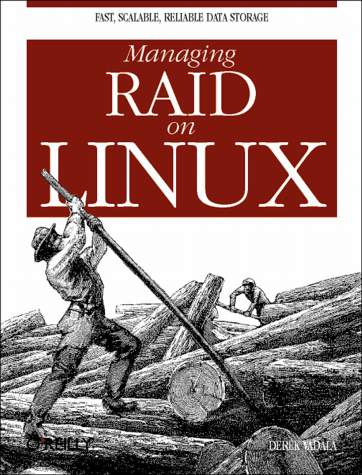- Description
-
Redundant Array of Independent Disks (RAID) technology is becoming a standard feature of computer systems that support mission-critical services like file sharing, mail exchange, or Web servers. RAID offers two benefits to these essential systems: improved I/O performance and fail-safe data storage.
Although bandwidth problems on networks are well documented, the internal data transfer bottleneck that exists at the hardware level in each system can also leave you with perplexing performance issues. RAID is a cost-effective and easy-to-manage way to alleviate this bandwidth problem by distributing the I/O load seamlessly across multiple disks and controllers.
RAID also provides uninterrupted data access through disk mirroring and parity algorithms. That means systems can remain online even during a disk or controller failure. RAID is scalable, making it robust enough for large, high-traffic sites and small, critical systems. By using RAID, system administrators can combine single disks into terabytes worth of data storage.
Managing RAID on Linux covers everything system administrators need to know to put together a system that can support RAID. You will learn about the different types of RAID, along with associated technologies and issues, and how to choose the best RAID system for your needs. With a step-by-step, hands-on approach, the author guides you through the installation of either Linux software RAID or a hardware RAID card. The book shows how to build an array and optionally install a high-performance file system. Contents include:
- An introduction to RAID and Linux
- Planning and architecture of your RAID system
- Building a software RAID
- Software RAID tools and references
- Building a hardware RAID
- Performance and tuning of your RAID system
RAID has become the low-cost solution of choice to deal with the ever-increasing demand for data storage space. Written for system administrators, power users, tech managers, and anyone who wants to learn about RAID technology, Managing RAID on Linux sidesteps the often-confusing vendor-specific approach you'll find elsewhere to give you the straight story on RAID. Even non-Linux users will find this book full of valuable material.
- Extrait
- Chapitre 2 "Planning and Architecture"
[PDF : 1.6Mo]
|
Sujets
(ou table des matières)
- 1. Introduction
RAID Terminology
The RAID Levels: An Overview
RAID on Linux
Hardware Versus Software
- 2. Planning and Architecture
Hardware or Software?
The RAID Levels: In Depth
RAID Case Studies: What Should I Choose?
Disk Failures
Hardware Considerations
Making Sense of It All
- 3. Getting Started: Building a Software RAID
Kernel Configuration
Working with Software RAID
Creating an Array
The Next Step
- 4. Software RAID Reference
Kernel Options
md Block Special Files
/proc and Software RAID
raidtools
mdadm
- 5. Hardware RAID
Choosing a RAID Controller
Preparing Controllers and Disks
General Configuration Issues
Mylex
Adaptec
Promise Technology
3ware Escalade ATA RAID Controller
LSI Logic (MegaRAID)
- 6. Filesystems
Basic Filesystem Concepts
The Linux Virtual Filesystem (VFS)
ext2
ext3 Extensions for the ext2 Filesystem
ReiserFS
IBM JFS
SGI XFS
- 7. Performance, Tuning, and Maintenance
Monitoring RAID Devices
Managing Disk Failures
Configuring Hard Disk Parameters
Performance Testing
Booting with Software RAID
- A. Additional Resources
- B. Hardware RAID Controller Vendors
|









